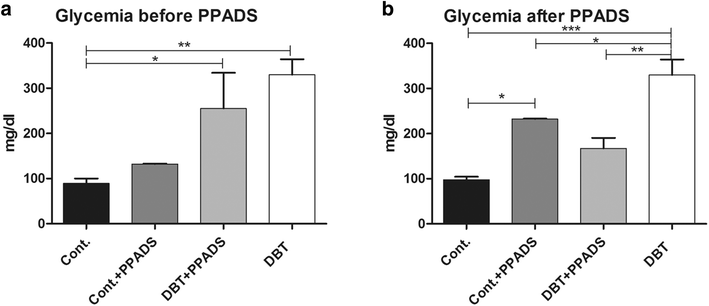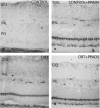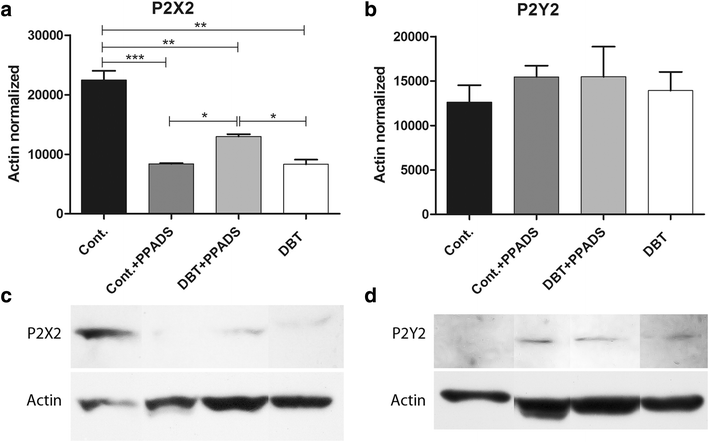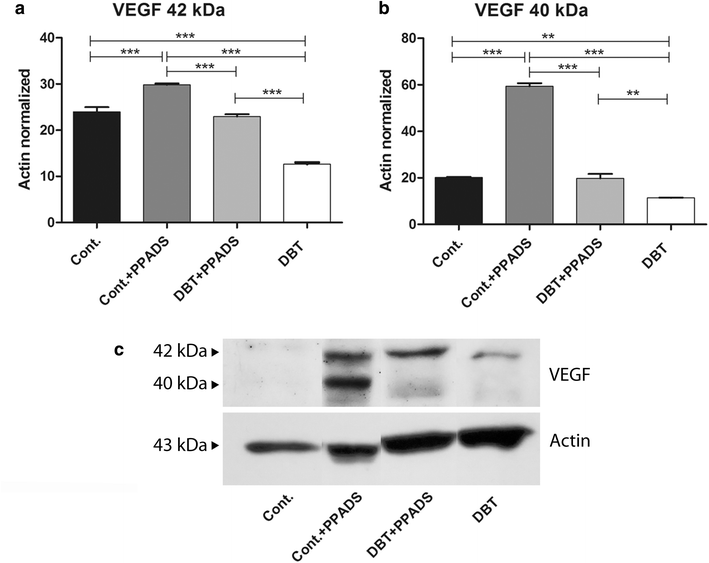Possible neuroprotective role of P2X2 in the retina of diabetic rats
- PMID: 29682007
- PMCID: PMC5898034
- DOI: 10.1186/s13098-018-0332-7
Possible neuroprotective role of P2X2 in the retina of diabetic rats
Abstract
Background: Purinergic receptors are expressed in different tissues including the retina. These receptors are involved in processes like cell growth, proliferation, activation and survival. ATP is the major activator of P2 receptors. In diabetes, there is a constant ATP production and this rise of ATP leads to a persistent activation of purinergic receptors. Antagonists of these receptors are used to evaluate their inhibition effects. Recently, the P2X2 has been reported to have a neuroprotective role.
Methods: We carried out a study in groups of diabetic and non-diabetic rats (N = 5) treated with intraperitoneal injections of PPADS, at 9 and 24 weeks of diabetes. Control group received only the buffer. Animals were euthanized at 34 weeks of diabetes or at a matching age. Rat retinas were analyzed with immunohistochemistry and western blot using antibodies against GFAP, P2X2, P2Y2 and VEGF-A.
Results: Diabetic animals treated with PPADS disclosed a much more extended staining of VEGF-A than diabetics without treatment. A lower protein expression of VEGF-A was found at the retina of diabetic animals without treatment of purinergic antagonists compared to diabetics with the antagonist treatment. Inhibition of P2X2 receptor by PPADS decreases cell death in the diabetic rat retina.
Conclusion: Results might be useful for better understanding the pathophysiology of diabetic retinopathy.
Keywords: Diabetic retinopathy; P2X2; PPADS; Retina; VEGF-A.
Figures








Similar articles
-
Involvement of purinergic P2 receptors in experimental retinal neovascularization.Curr Eye Res. 2008 Mar;33(3):285-91. doi: 10.1080/02713680701885470. Curr Eye Res. 2008. PMID: 18350440
-
An endothelin type A receptor antagonist reverses upregulated VEGF and ICAM-1 levels in streptozotocin-induced diabetic rat retina.Curr Eye Res. 2006 Jan;31(1):79-89. doi: 10.1080/02713680500478923. Curr Eye Res. 2006. PMID: 16421022
-
Effect of endothelin dual receptor antagonist on VEGF levels in streptozotocin-induced diabetic rat retina.Exp Biol Med (Maywood). 2006 Jun;231(6):1090-4. Exp Biol Med (Maywood). 2006. PMID: 16741055
-
Sustained stimulation of vasopressin and oxytocin release by ATP and phenylephrine requires recruitment of desensitization-resistant P2X purinergic receptors.Am J Physiol Regul Integr Comp Physiol. 2009 Oct;297(4):R940-9. doi: 10.1152/ajpregu.00358.2009. Epub 2009 Jul 22. Am J Physiol Regul Integr Comp Physiol. 2009. PMID: 19625689 Free PMC article.
-
P2X1 and P2X2 receptors in the central nervous system as possible drug targets.CNS Neurol Disord Drug Targets. 2012 Sep;11(6):675-86. doi: 10.2174/187152712803581128. CNS Neurol Disord Drug Targets. 2012. PMID: 22963438 Review.
Cited by
-
Purinergic System Signaling in Metainflammation-Associated Osteoarthritis.Front Med (Lausanne). 2020 Aug 28;7:506. doi: 10.3389/fmed.2020.00506. eCollection 2020. Front Med (Lausanne). 2020. PMID: 32984382 Free PMC article. Review.
References
-
- Ralevic V, Burnstock G. Receptors for purines and pyrimidines. Pharmacol Rev. 1998;50:413–492. - PubMed
LinkOut - more resources
Full Text Sources
Other Literature Sources
Miscellaneous

